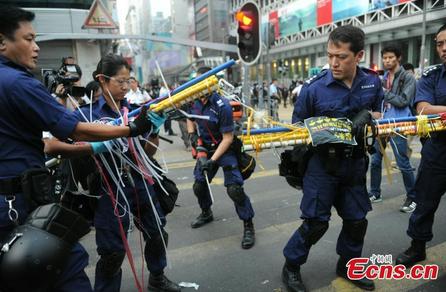

Hong Kong police remove blockades erected by Occupy Central students at a protest site in the bustling area of Mong Kok, Hong Kong on October 17, 2014. (Photo: ECNS)
Around 3 pm Thursday in Mong Kok, one of the three occupy protest sites in Hong Kong, a group of men arrived on Argyle Street.
They claimed that they had come "for justice" as they removed road blocks and other makeshift barricades to clear the street and force Occupy protesters to withdraw.
This move immediately provoked dissatisfaction from demonstrators. And just before the situation reached critical mass, hundreds of police rushed in the middle, hand in hand, separating the two sides.
This scene stands in contrast to the September 28 incident on Connaught Road, where lines of helmeted police officers carrying riot shields used tear gas and pepper spray to disperse the crowd.
Police hurled a total 87 tear gas grenades at protesters that day. At least 30 people were injured.
The incident sparked worldwide debate as to whether Hong Kong police have been using excessive force, or not enough to maintain control.
Stress points
"Over the past few weeks, my colleagues and I have been under extreme stress," a frontline police officer told the Global Times under condition of anonymity.
"Since the day that some of our colleagues used tear gas, I have encountered many protesters who said horrible things to me because they do not agree with what we did," he said.
Police had not used tear gas in Hong Kong since protests led by South Korean farmers against the World Trade Organization in 2005.
Secretary of Security, Lai Tung-kwok, said that the use of tear gas was necessary in order to "deal with crowds that may have gotten out of control and, therefore created a dangerous situation, or to stop and prevent crowds from continuing to charge at police so as to ensure public safety, restore social order and avoid injuries to both the crowds and the police officers."
He also argued that tear gas is "standard piece of police equipment for crowd control" in many European countries.
Protesters, however, condemned the police's decision.
"I think there were better ways to disperse the crowd other than using tear gas. Eighty-seven canisters is unacceptable," a volunteer surnamed Lai, who has been participating throughout the movement, told the Global Times. "The protesters were mainly unarmed students. The police should not have thrown tear gas into the crowd, which could cause people to panic and result in a stampede," said Lai.
According to a recent survey conducted by the Chinese University of Hong Kong's Centre of Communication and Public Opinion, 54 percent of the total 802 respondents agreed that it was "inappropriate to use tear gas" on September 28, while 22 percent called it an "appropriate act."
Copyright ©1999-2018
Chinanews.com. All rights reserved.
Reproduction in whole or in part without permission is prohibited.